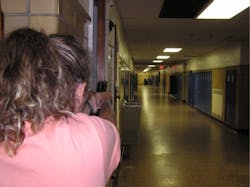Editor’s note: This article originally appeared in Law Enforcement Technology magazine and is reprinted with permission.
A school resource officer is an embedded police presence in an educational setting. Their purpose is to bridge the gap between local law enforcement and our youth. In that respect, the benefits of having an SRO varies from district to district. If applied correctly, the SRO concept does exactly what law enforcement agencies are striving to do—it is a foundation and a model for community policing.
I had an opportunity to sit down and talk with SRO Rick Macchia about his duties. He has about 15 years of experience on campus and finds his job completely distinct from his time in a patrol car.
Up until a few years ago, Macchia worked with Principal Robert Marvulli, a school administrator with over 30 years of experience. They described the unique relationship between the SRO and the school principal.
People Misinterpret Their Duties
People sometimes misinterpret the purpose of an SRO, says Macchia. Occasionally he will have a teacher approach him who had a conflict with a student in the classroom. Some school employees attempt to get SROs involved in the disciplinary process. As such, the relationship between administration and the SRO often becomes blurred. Searching students can be a tool for maintaining safe schools, but there is a balance between individual rights and a safe learning environment.
Students have a reasonable expectation of privacy, which is not waived when they enter school grounds. A law enforcement officer requires probable cause. Warrantless searches conducted by school authorities require reasonable suspicion related to the scope of circumstances. School administrators are responsible for understanding the intrusiveness of the search considering the age and gender of the student.
Search and Seizure is Different
The other part of the blurred lines is the response to the student violation itself. Most schools have a code of conduct that states that an SRO doesn’t intervene until it is a violation of criminal law. That is, if a student violated a district policy or a code of conduct, they don’t take a student into custody.
Students can voluntarily answer an SRO’s questions, outside of interrogation. They have no obligation to speak to an SRO when it comes to criminal conduct. They do, however, have an obligation to speak to a school administrator.
Macchia says that the location of the SRO’s office is fairly important. They need to be strategically placed in order to respond to situations involving the safety of the campus. They also need to have a secure area to store equipment.
In many SRO offices there are screens which monitor the cameras on campus. These are excellent investments and a consideration when grant money is available.
Third, student privacy is critical. The very fact that a SRO meets with a student should be protected under the law. The SRO office should have the ability to ensure the privacy of the juvenile.
Keeping Juveniles Out of the System
Macchia says that although it isn’t said overtly, the purpose of an SRO is to keep juveniles out of the system. An SRO is there to prevent widening of the net. “You can’t hire any street officer to be an SRO,” he adds.
They had an incident where a juvenile had drugs on his person while on campus. The incident was handled through the school, not the juvenile justice system. There are obviously certain criminal offenses that require legal intervention, like drug sales, use of weapons, and similar conduct.
There is a particular temperament that goes with the job of an SRO, says Macchia. The officer has to be familiar with board policy, the education code, and school specific training like A.L.I.C.E. When it comes to creating a formal threat assessment for the school, the SRO has a significant amount of input. They are used to the day-to-day rhythm of the school.
Marvulli says it is impossible to know what goes on in the home of every student, including the possibility of their having access to firearms and drugs in the home. As a liaison between the local agency and the school, an SRO can provide a little insight as to the credibility of a threat to a campus. They can validate information in a particular threat regarding scheduling or an activity of the school. More importantly, an SRO can provide a calming effect to the students and staff. One effect he found especially true after the Sept. 11 attacks. Of the significant roles an SRO plays on campus, the most intangible is the most important.
An SRO occasionally assists administrators with home visits. Some students require “welfare checks” and visits sometimes include a child welfare and attendance supervisor.
Monitoring Cameras
An SRO’s response to emergencies is completely different than the typical response pattern of a patrol officer. For many SRO’s, dispatching is done through more than one means. Macchia carries two radios: one from his agency, the other from the school. One routinely sends a backup or cover unit automatically. In most calls for service, including a threat on campus, the SRO responds alone. Often, an emergency on campus requires the school administrator to respond to his or her office, and the SRO to the scene. It is extremely beneficial for the SRO to have an administrator warning them of hazards by scanning the cameras as he responds. Even during an active shooter incident, it is imperative to have someone on the monitors.
Monitoring cameras is completely counter intuitive. Every administrator is going to do whatever it takes to keep kids on campus safe. They will want to help rather than scan monitors. This may be the greatest help they can offer for responding units. With this in mind, the monitoring area must have restricted access but to backup people capable of interpreting what they are seeing. Whoever is doing this must stay on the line with police dispatch.
Educate the Campus
One of the most common lessons learned in training is that faculty and staff are rarely educated about what would happen in an emergency. They receive training, but don’t get realism in their scenarios. For example, one group commented about the fact that the SRO bypassed “injured” role players. They ran past panicked students, straight to the active shooter. Apparently, some teachers did not know ahead of time that this was going to happen.
The same goes for cellphones as some school administrators make it a point to discourage them on campus. When I talked to Macchia about this, I told him that I had actually responded to a few calls on our high school campus that were made by students, unbeknownst to administrators. I told him I was a firm believer in having cellphones on campus.
Macchia says he had been on campus before when there was a telephone bomb scare. “Cell phones create a target rich environment,” he says.
During one incident, parents began showing up demanding their kids be taken out of school, even before that details about the bomb scare had been disclosed. He was amazed that so many parents brought their toddlers with them to pick up their high school students during a bomb scare. If the person making the bomb scare had an ulterior motive, it certainly could have been accomplished. I guess the other part of the equation is to have very timely social networking announcements.
Finding Qualified SRO Recruits
Sheriff Adam Christianson of Stanislaus County, Calf., informed me something I didn’t know. I thought that the Juvenile Services Unit’s SRO program has diminished because of budgetary concerns. He says they have a “fully supportive board” when it came to providing law enforcement services in the area.
It’s not a budget issue. The problem is there are not enough well qualified recruits. Since answering calls for service is a higher priority, filling vacant SRO positions has to wait.
Patterson, Calif., is one of the contract cities for the Stanislaus County Sheriff’s Department. It is also one of the few contract cities under the Sheriff’s office that has an SRO. Patterson Police Chief Jeff Dirkse says that SROs will become involved in crimes of violence, and more serious activities, but schools should deal with most of their violations internally.
Patterson’s local SRO, Deputy Gabe Ramirez, is ideal for the job. Dirkse explains that Ramirez grew up in an area where he was very familiar with local gang activity. He has been known to comment about becoming a deputy to “try to keep kids out of that.” Ramirez attends football games, helps out with coaching, and “really gets to know his students.”
Dirkse also told me that the police administration’s relationship with the school administration is very important, and the agency continually maintains a dialogue with the school.
To read this story in its entirety, click here
About the Author

Lindsey Bertomen
Lindsey Bertomen is a retired police officer and retired military small arms trainer. He teaches criminal justice at Hartnell College in Salinas, California. He has a BS in Criminal Justice and an MS in Online Teaching and Learning. Lindsey has taught shooting techniques for over a decade. He enjoys competing in shooting sports, running and cycling events. He welcomes comments at [email protected].
